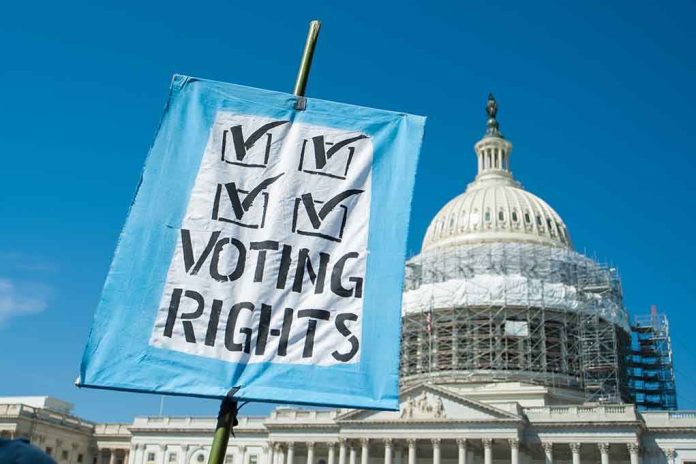
The Supreme Court has ordered supplemental briefs in a Louisiana redistricting case that could fundamentally reshape how states balance constitutional equal protection with federal voting rights mandates, potentially dismantling decades of race-conscious electoral map drawing.
Story Highlights
- Supreme Court orders briefing on whether Louisiana’s second majority-Black congressional district violates constitutional amendments
- Case tests tension between Voting Rights Act compliance and Equal Protection Clause limits on racial gerrymandering
- Decision could set national precedent affecting minority representation in congressional districts nationwide
- Louisiana’s disputed map stretches 250 miles to connect Black communities into single voting district
Constitutional Question Takes Center Stage
On June 27, 2025, the Supreme Court directed parties in Louisiana v. Callais to submit supplemental briefs addressing whether intentionally creating a second majority-minority congressional district violates the Fourteenth or Fifteenth Amendments. This directive signals the Court’s focus on the fundamental constitutional limits of race-based redistricting, moving beyond statutory interpretation to core constitutional principles that should govern how electoral maps are drawn.
Supreme Court to Decide Legality of Key Voting Rights Act Provisionhttps://t.co/QG3LARMNc8
— RedState (@RedState) August 2, 2025
The Court’s order comes after years of litigation over Louisiana’s congressional maps, where federal courts initially found the state’s original single majority-Black district likely violated the Voting Rights Act. Louisiana responded by creating a second majority-Black district, but this remedy now faces constitutional challenge as an impermissible racial gerrymander.
The Map That Sparked Constitutional Debate
Louisiana’s contested congressional map, known as SB8, creates a second majority-Black district by connecting Black communities across a 250-mile stretch. The district court ruled this configuration violated the Equal Protection Clause, finding race was the predominant factor in drawing boundaries without sufficient justification. However, the Supreme Court granted an emergency stay in May 2024, allowing the map to remain in effect pending final resolution.
Civil rights organizations argue this map is both constitutionally permissible and necessary to prevent discrimination against Black voters, who comprise one-third of Louisiana’s population but historically held only one-sixth of congressional representation. The NAACP Legal Defense Fund contends that failing to create adequate majority-minority districts perpetuates historical voting discrimination that the Voting Rights Act was designed to remedy.
Stakes Beyond Louisiana’s Borders
This case carries implications far beyond Louisiana’s six congressional districts. The Supreme Court’s eventual decision will establish binding precedent for how states nationwide may consider race when drawing electoral boundaries. The ruling could either reinforce the Voting Rights Act’s mandate for minority representation or significantly constrain states’ ability to create majority-minority districts.
The timing is particularly significant given recent Supreme Court decisions that have shown increasing skepticism toward race-conscious government actions. While the Court reaffirmed Voting Rights Act protections in Allen v. Milligan (2023), requiring Alabama to create a second majority-Black district, the current case directly challenges whether such race-conscious remedies can themselves become constitutional violations when states voluntarily comply with federal voting rights mandates.
Constitutional Principles vs. Federal Mandates
The core tension in this case reflects a broader philosophical divide about the proper role of race in American governance. Conservative constitutional principles emphasize equal treatment under law regardless of race, suggesting that deliberately drawing districts based on racial demographics violates fundamental equal protection guarantees. The Fourteenth Amendment’s Equal Protection Clause was designed to ensure government treats all citizens equally, not to create race-based political advantages.
Critics of Louisiana’s map argue that stretching a congressional district 250 miles primarily to capture Black voters represents exactly the type of racial gerrymandering the Constitution prohibits. When race becomes the predominant factor in political boundary-drawing, it undermines the principle that representation should be based on shared interests and geographic communities rather than racial identity. This perspective aligns with conservative values emphasizing individual merit over group identity and constitutional limits on government’s use of racial classifications.
Sources:
NAACP Legal Defense Fund – Louisiana v. Callais FAQ
Supreme Court Order – Case No. 24-109
American Redistricting Project – Callais v. Louisiana
Oyez – Louisiana v. Callais Case Summary
League of Women Voters – Racial Vote Dilution Analysis





